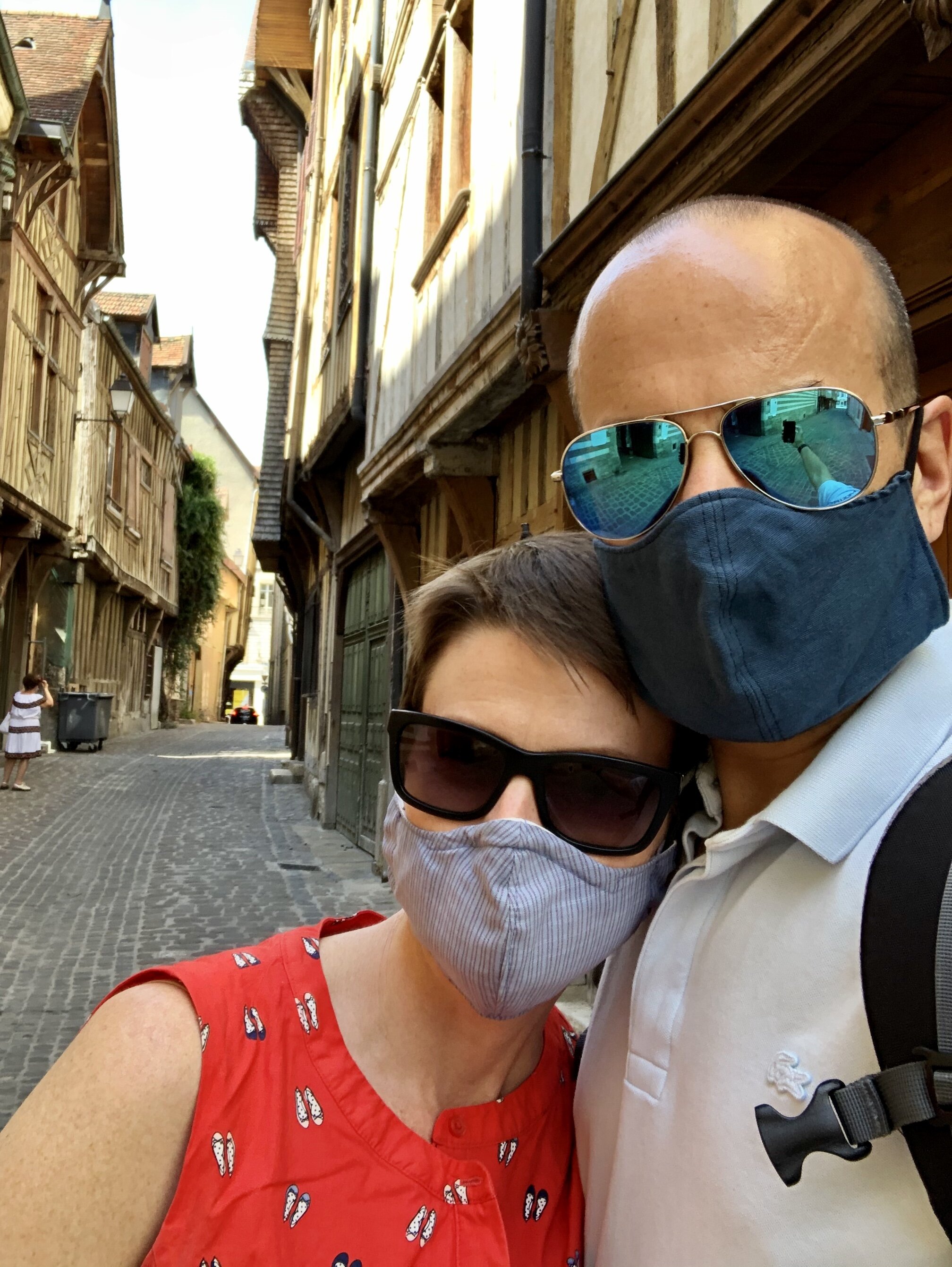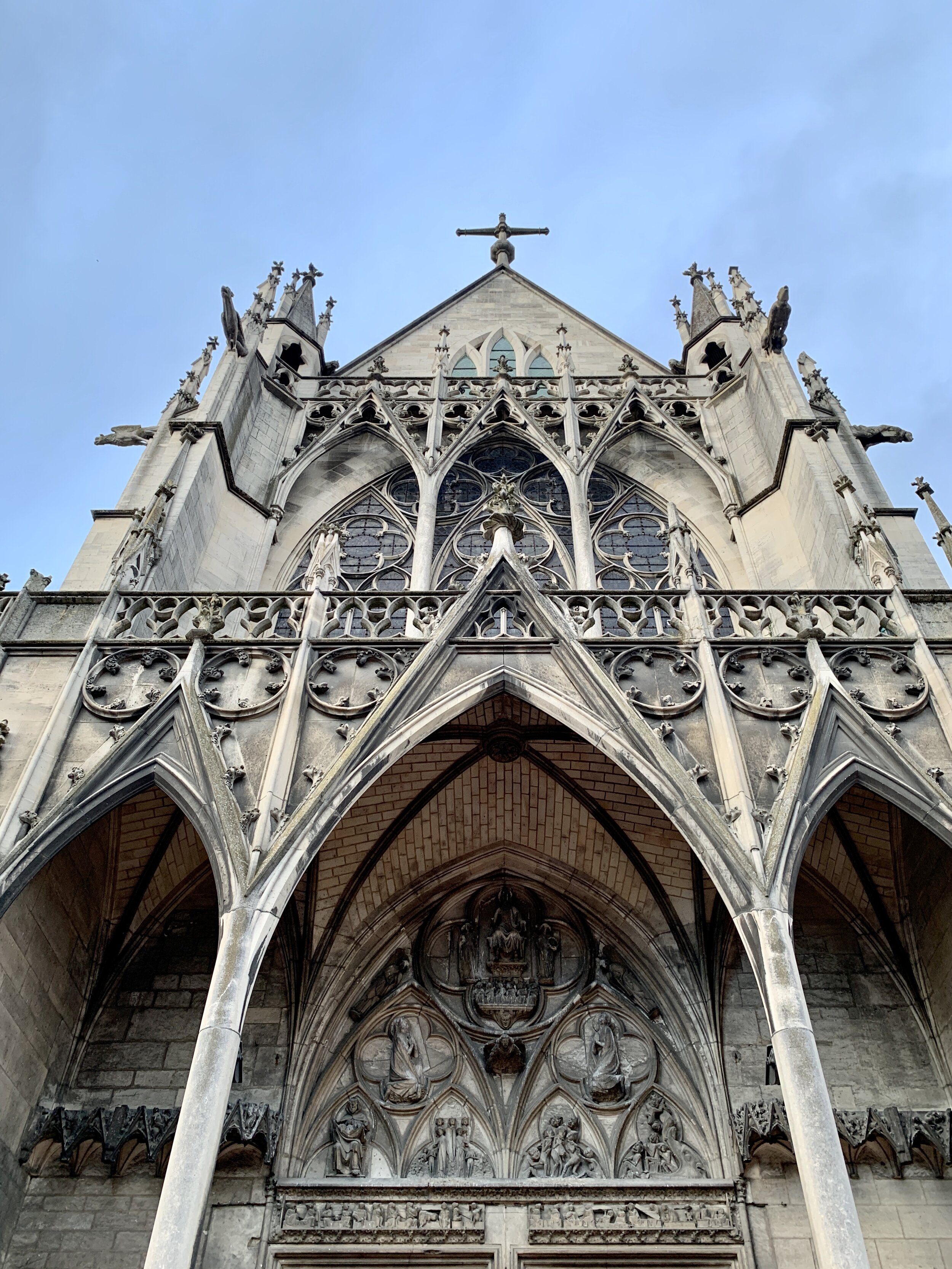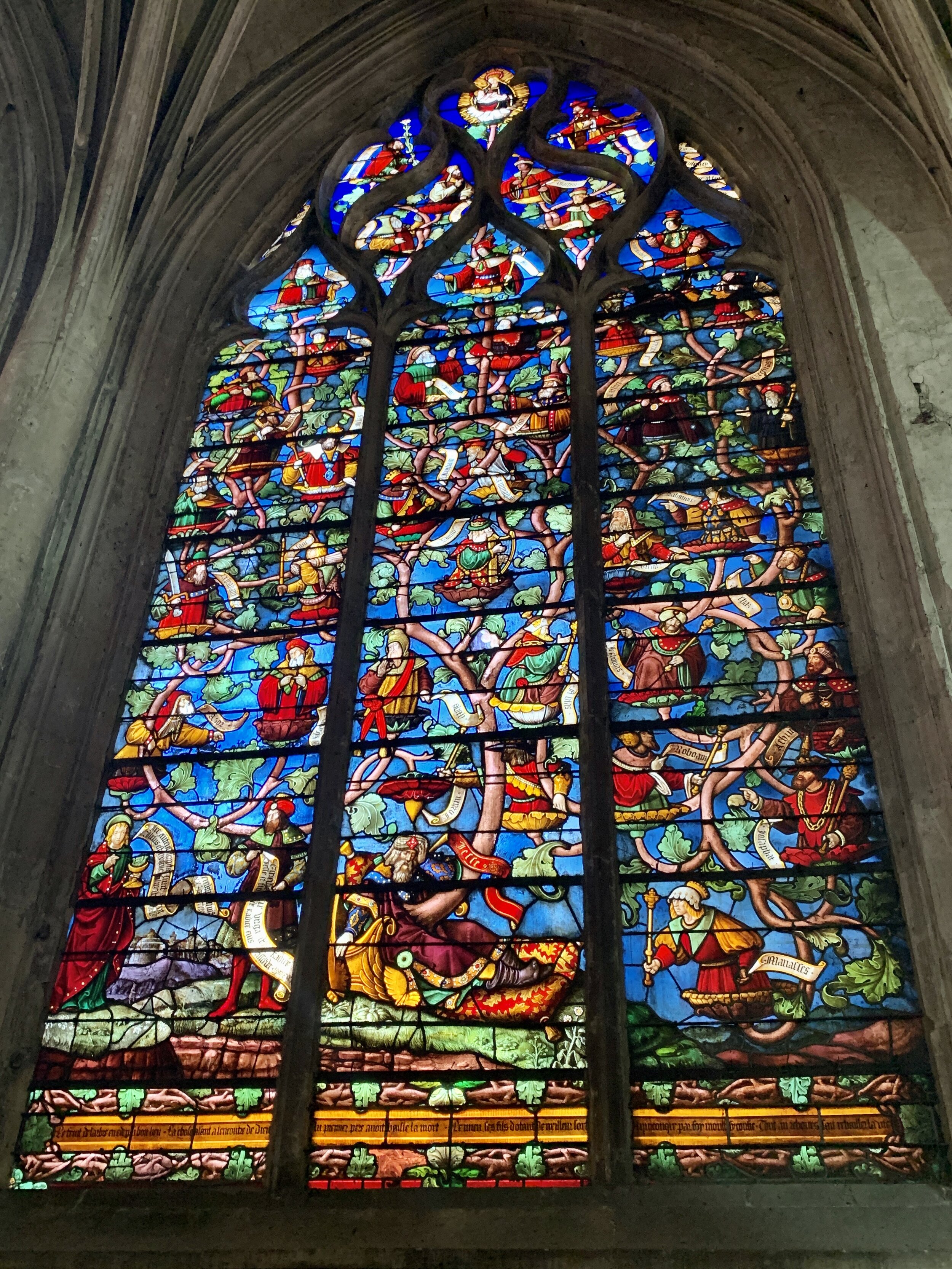A Vacation to Troyes, France
Masked up (a sign of the COVID-19 times) and walking the Renaissance streets of Troyes, France. August 10, 2020.
In researching options for a summer trip, we had three major criteria:
We aimed to find a spot in France we could easily reach by car from our base in Lausanne, Switzerland, without losing an entire day driving on both ends of the trip.
We sought somewhere we hadn’t yet visited and that wouldn’t have tourists and travelers crammed into every nook and cranny.
We wanted a spot urban enough in terms of amenities, yet with historical interest and near enough to a larger region full of sights and activities. We planned to stay in one spot and explore large swaths of a surrounding region or regions of France.
I hear you: Not exactly a checklist easily covered.
And yet! Though we needed no minor amount of time reviewing maps and guidebooks and websites—weeks, even—we finally decided to spend time in the Champagne and Burgundy regions of France with a base of stay in Troyes.
Did Troyes deliver? Sure did, my friends. Sure did.
Troyes has a deeper well of history than even I could plumb, every amenity we could have wanted conveniently located in the center of the city, and walking-distance outdoor fun in the form of river kayaking and national-park hiking.
Even better? Troyes is relatively undiscovered in its beauty and adventure by tourists—even French tourists. (However, a note for people who do not speak French: You will get along fine without French fluency in Troyes and the surrounding regions, yet you should bring a phrasebook and expect that you won’t have options for certain guided tours.)
Start with the Troyes Office of Tourism
Ahead of your trip to Troyes, visit the website for the Troyes Tourist Office—truly one of the better ones I’ve found in my travels.
On the Troyes tourist office’s website, you’ll find ideas to help you organize your stay via overviews of the metropolitan area’s various historical and cultural sites and activities. I loved the site’s trip-ideas section, in which they’ve presented activities in the immediate area that you may not have otherwise known existed; even better, they provide contacts, links, and key information to make taking advantage of these activities accessible. For example, we never would have known we could go kayaking or have thought to research rentals in the area without the tourist office’s website presenting it as an option and providing phone numbers for an operator in town.
The office of tourism in central Troyes, France. Don’t miss a stop here for great ideas! August 10, 2020.
When you arrive, even if you’ve planned in advance via the website, the physical tourist office in the center of Troyes will give you a wealth of additional options, maps, brochures, and guides to provide more ideas and clue you into activities underway during the dates of your visit. You can buy tickets to walking tours here as well; I recommend highly the ninety-minute walking tour of the city center for a grounding overview of the history of the city and what you see when you walk around Troyes.
Also, although the office has a free map available to anyone, I recommend paying the negligible fifty cents for the tourist office’s map that provides a self-guided walking tour of the historic heart of the city, which they have available in French and in English.
The map has a well-arranged walking path (which the city has marked via bronze plates embedded in the streets and sidewalks as well) and small descriptions of each site of importance; you can do the tour over several days, as I did.
This negligible-cost map takes a pleasant stroll of the city to new heights, giving you depth of historical understanding and pointing out picturesque streets, squares and courtyards, and architectural details you’d otherwise miss.
Multiple Layers of French History
In Troyes, even if you take my walking-tour recommendations, you’ll benefit from stopping when you see a historical sign and reading the details. I had an unassuagable feeling that no matter how much I tried to learn about the history of Troyes, I had so much more I could still learn.
Troyes has roots stretching well back into the Roman era and likely before, much of which history it has well documented and attempted to preserve as best it can. The city seems not to have truly had a fallow period; it segued almost directly from a vibrant Roman center into a bustling medieval urban area.
During the middle ages, Troyes served as the founding seat for the Knights Templar (L’Ordre des Templiers). Though many of the sect’s sites have burned or have crumbled into history, a few sites remain in and around Troyes, and area museums exist to walk you through the history of the group, the mythology surrounding it, and the personalities involved.
During the medieval period, Troyes suffered a tragic fire that consumed most of its city center. Once the ash settled, it rebuilt in the then-latest French-Renaissance style, an architecture it has proudly preserved. When you walk through the streets of Troyes, you’ll feel transported into a past century.
Quirky Museums in Troyes
As do most reasonably sized cities, Troyes has its art museums (modern and otherwise). However, Troyes’ quirky, offbeat museum offerings truly distinguish it from other medium-sized towns.
While in Troyes, you can visit a museum dedicated to the ancient pharmaceutical arts (Apothicairerie de l’Hôtel-Dieu-le-Comte), a museum dedicated to hosiery (Musée de la Bonneterie), a museum dedicated to stained glass (Cité du Vitrail), and a museum dedicated to tools (Maison de l’Outil et de la Pensée Ouvrière).
I admit to a lack of enthusiasm at the idea of a tool and manual-labor museum; if we’d skipped it entirely in favor of other activities, I wouldn’t have complained—and I wouldn’t have known what I’d missed.
La Maison de l’Outil et de la Pensée Ouvrière in Troyes, France, is astonishing. The displays form works of art in their own right, highlighting workers, their tools, and their creations with reverence. August 14, 2020.
For this reason, I call it to your attention: If you, like me, would have passed on seeing the Maison de l’Outil et de la Pensée Ouvrière, think again.
The museum has beautifully restored its historic building and it has put incredible thought and detail into creating works of art with tools that span dozens of trades and centuries of workers. Collectively, the exhibits and the museum pay homage to the labor of humans over the years and illuminate the false distinction between “fine art” and “utility items.”
So. Many. Churches.
I don’t know where to start with the churches in Troyes.
In a relatively small city—especially by American terms—to find eight sizeable historical churches, one of which the Catholic Church has designated a basilica and another of which they’ve named a full-on cathedral, astounded me.
With such a richness of options, I find it almost impossible to point you toward a favorite if you have time or interest in seeing only one or two religious sites in Troyes. All have grandeur, elegance, and historical significance.
However, if you twist my arm, I’d point you toward these three:
The exterior of the Basilique Saint-Urbain delighted me because it provides an opportunity to see a church’s evolution across five centuries, from the eighth century to the thirteenth. Each epoch added onto the church in the architectural vogue of its time, thereby creating a history book of an edifice—at least when it comes to church architecture of these periods. To get the best perspective, view it along its two longest sides.
Perhaps because I spent more time looking at its stained-glass windows than I did the windows in the other Troyes churches—their lower positioning here make them more accessible for investigation—I’d recommend you visit the Èglise Sainte-Madeleine and head to the back of the church, beyond the worth-seeing stone rood-screen to view the ancient yet surprisingly modern and fresh-feeling stained-glass windows. My favorites covered stories from the Old Testament, including the stories of Genesis and the Tree of Jesse.
If you get the chance, go inside the Èglise Saint-Jean-au-Marche. I never saw it open except for one night at the end of a saints’ day in France, ahead of a music service. I quietly entered and walked around this almost cozy—by church terms—space. This church has stood in its spot since Roman times; it doesn’t have nearly the level of ornate detail as the other churches, yet it has an intimacy that they lack.
I don’t list the cathedral in this summary, as you may note. Don’t assume that this means I didn’t appreciate seeing it—I appreciated all the many churches in Troyes. If you have time and opportunity to see them all, do it. (And if you really want to see more churches, drive up to Reims for the day.)
Outdoor Fun in Troyes
Troyes is bordered in part by the Seine River (yes, the same one that flows through Paris) and nestles not far from one of the Champagne region’s two main natural parks.
This means that while staying in the heart of this bustling and vibrant city, you can take a few steps or a short drive to reach all kinds of outdoor activity. A nearby airfield offers glider trips, guides will take you on hikes through the woods, you can rent bikes to go mountain biking on the park trails, and you can rent kayaks and get a ride up the Seine to float back into town.
I still can’t believe that we could walk ten minutes from the center of town to the kayaking operator, who put us and a few other people into her van with kayaks trailing behind and drove us up river to a drop-off point from which we kayaked about ten kilometers down the Seine to our starting point. On a ridiculously hot August day, the freshness of the tree-shaded river brought much needed relief. (We saw several others getting out of the heat on the water, too, many of whom we surprised without their clothes when we appeared. Whoops!)
Kayaking on the Seine River through Troyes, France. August 9, 2020.
The kayaking experience proved one of the most vibrant memories of our trip. Highly recommended.
Without a guide, we didn’t really know how to get into the national park successfully for a good hike; further, we hadn’t thought to bring proper hiking shoes. If we go back to Troyes, I’d plan to book a guide for a day’s hiking—the woods we could see from river level during our kayaking trip looked magnificent (and a hike in the woods in the heat of summer would have felt delicious).
Dining in Troyes: Food and Restaurants
For most of our stay in Troyes, we feasted on food from the covered market, also known as les halles.
Unlike many markets in France, the covered market in Troyes stays open seven days a week (though Sundays and Mondays don’t have as many stalls doing business). In les halles, you’ll find everything you need for picnics, snacks, and even cooking meals if you have a kitchen available to you.
You’ll find as well addictively delicious chocolates: Maison Caffet has a storefront in Troyes as well, but the ability to pick up macarons and chocolates while buying our cheese and charcuterie at the market proved just too convenient (and tempting) each time.
We lucked out by having the best bakery and patisserie we found in town—we tried a few—catty-corner to the AirBNB we’d rented: We found the bread and the desserts at Boulangerie Pâtisserie Gérard absolutely divine.
Despite cozying up in our AirBNB with treats from les halles and the bakery for most of our meals while in Troyes, we did make our way to a couple of restaurants worth a mention during our Troyes trip: We had a delightful dinner on the interior-courtyard terrace of Les Tables des Peintres one evening—the food came fresh and simply yet deliciously prepared and the proprietor was a joy, making the entire meal warm and inviting. And on our last night in town, we had a very hearty meal on the beautifully on-point interior courtyard at Chez Felix; we’d recommend a meal there as well, if you crave a night out.
Fresh mozzarella and tomatoes on the terrace at Chez Felix in Troyes, France. August 19, 2020.
Of course, we couldn’t consider a summer vacation spot a success if we couldn’t find good ice cream for Arnaud (even if we don’t expect to find another ice cream purveyor quite as good as what we found in Provence or our gelateria of choice in Florence). We happened upon Coeur Glace while walking through town; it has an entire menu of gourmet flavors created in-house from organic ingredients. Arnaud gave it a high thumbs up and a hearty recommendation for ice cream lovers visiting Troyes.
Only Have Time for a Brief Stop in Troyes?
If you only have a few hours in Troyes, I’d recommend you pop into the tourist office to buy the walking-tour map I mentioned and follow it through the city, stopping into whatever sites interest you and that time allows.
If you have more time—say a weekend—I’d recommend highly that you add onto the walking-tour recommendation a visit to one church, a picnic lunch from the covered market (including macarons from Maison Caffret), a kayaking trip or a hike, and a pop into the Maison de l’Outil et de la Pensée Ouvrière, followed by a more leisurely meal at one of the restaurants along the Ruelle des Chats (try Les Tables des Peintres).
Whether you have only a few hours or two days, you can’t go wrong with a stop in Troyes.








































